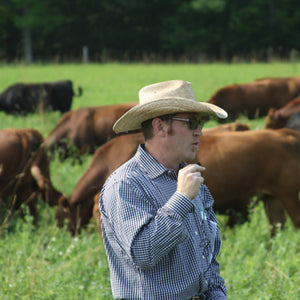In 2005, Hurricanes Katrina and Rita rocked the southeastern United States. The storms blew apart communities across thousands of miles, leaving millions without access to food, water, and other critical resources. Seemingly overnight, the region — especially Louisiana — was stripped of any semblance of modern society. Jason Rowntree, then an assistant professor in the School of Animal Sciences at Louisiana State University, was shocked by the food insecurity that hit the region once the flood waters subsided.
“I was south of New Orleans, a place where they grew rice, citrus, beef cattle, and had vibrant fishing and shipping industries, and there was practically nothing to eat,” Rowntree explained, recalling his experience as a food security first responder. “Everything being grown there was meant to contribute to larger processed food operations, so there was very little local infrastructure. We were in the land of agriculture and there was nothing to eat.”

Jason watched as the area’s access to food transformed from first-world to third-world conditions. The system’s fragility and dependence on outside resources was unbelievable. There was simply no regional resiliency or food independence. The conventional agriculture practices Jason grew up with in East Texas, studied in school, and taught, failed when they were needed most. He had to take action.
So Jason did what he does best: research. He began scouring for information outside of the academic realm, determined to find a way to create a more resilient, localized agriculture model. That’s when he discovered Allan Savory and holistic management, which emphasizes responsible land stewardship by helping ranchers better fit their agricultural practices to their available natural resources. As a man raised in the world of uniform, one-size-fits-all production practices, it was like nothing Jason had ever seen. He devoured every piece of Savory Institute material he could find. “The more I read, the more I knew holistic management was the recipe for moving forward,” Jason reflected. “Since then, I’ve made it my life’s work. I know we can improve societal health and quality of life through agriculture and land management.”
Around that time, Jason returned to Michigan State — where he’d earned his PhD several years before — as an Associate Professor in the Animal Sciences department. This position gave him a platform to secure university resources to explore holistic management, but he had to be careful: many of his peers and stakeholders had invested time and money into the model he was denouncing. Nonetheless, Jason was eventually given the opportunity to convert the school’s research center into a regenerative ag laboratory. It was his chance to make some serious waves. “We took a normal commercial farm and flipped it on its head overnight,” he explained. “We started doing a lot more intensive soil monitoring and seeing important, quantifiable changes in land and animal health. It seemed natural, but it was the first time a large public university was operating under a holistic context.”

Getting the university to give holistic management a shot was only the beginning, though. Jason continued pushing things further until Michigan State officially became a Savory Institute Hub in 2015. Through this, he and his partners successfully brought revolutionary land management ideas into the rigid world of academia — an unthinkable achievement just a few years before. Thanks to the program’s newfound and unique academic-NGO relationship, their facility suddenly had a unique vantage point and access to resources other hubs didn’t. “Becoming a hub gave us the chance to make the science behind the movement more sound and allowed us to get holistic management into our classrooms and research centers,” he said. “Now more than ever, our close ties are helping us aggregate data and quantify land impact in ways we can communicate to stakeholders and consumers that can also pass scientific rigor.”
That’s only half the answer to Jason’s food security quest. Luckily, creating regional outlets for food producers is one of the key components of holistic management. So as he continued to run soil tests and measure animal impact on land, Jason helped launch grass-fed markets in the Upper Great Lakes area. He wasted little time, spearheading a multi-pronged effort to connect distributors with local demand. Right away, he realized how fractured the system was, even in his own backyard. There were suppliers grass-finishing 500-1,000 heads of steer a few miles from MSU campus, and none of that meat was being routed through campus. “We’re serving beef in our cafeterias and restaurants, we’ve got thousands of people tailgating at football games, and none of that is coming from our local community?” he marveled in disbelief. “With the way things were set up, it was easier to get those cattle to Omaha or Houston than five minutes up the road.”
A few years and many meetings later, Jason had turned things around. These days, Michigan State gets 80% of its beef from local suppliers — an incredible feat considering the school is home to over 50,000 students. It’s an example he often cites to show that, despite common misconceptions, local economies can quickly be altered to best fit their communities’ needs. And since it lends itself to operations focused less on maximizing output and global logistics and more on meeting nearby needs, this localized approach creates mutually beneficial relationships for producers, consumers, the land, and the animals. The best part is, this model can be used by any community, regardless of where it’s located. “Every context is different when it comes to a local food system,” he explains. “That’s why it’s crucial to understand the different factors in various geographical regions. We’re just designing a system to help local producers and consumers form a strong, sustainable relationship with their natural resources.”

Jason and his research team are always in the field taking measurements and getting their hands dirty.
The impact of this system is threefold. In addition to fueling local economies — Jason estimates that every dollar spent on beef cattle in a localized model has a $3.00 multiplier effect — and giving them stronger food security, holistic land management can also sequester carbon from the earth’s atmosphere by healing damaged lands. It’s simple: with stronger, taller vegetation in place, greater amounts of carbon can be put back into the soil. Jason’s especially passionate about this component, which is why Michigan State’s holistic program has made it a priority and taken precise soil health and carbon measurements since day one. There’s still plenty of work to be done, he says, but they’re on the fast track to publishing quantitative evidence that animal impact can offset CO2 emissions entirely. But to truly exploit this potential, these breakthroughs can’t remain in the doldrums of academia. The information has to go public.
That’s where the Land-To-Market program comes in. Working closely with EPIC and The Savory Institute, Michigan State is helping develop a system that would allow holistically-raised meat products to bare a regenerative label. This wouldn’t just give responsible companies and producers the recognition they deserve — it would allow consumers to put their money behind food products they know are having a positive impact on the land. It’s the perfect marriage of academic research and consumer-driven markets. “If we’re going to feed the world long-term, we have to be in sync with the natural processes that have preserved earth for millennia,” Jason said. “Our best solution relies on developing methods that produce high amounts of nutrient-dense, high-quality food in localized, sustainable manners. The Land-To-Market program will do exactly that.”

While the progress Michigan State has made in less than a decade is remarkable, it’s helped uncover more questions than answers. With yearly fluctuations in key climate factors like rainfall and temperature, researchers are focused on creating a process, not finding a clear-cut answer. This long-term approach won’t just aid their efforts to establish important trends in their neck of the woods: it’ll help create a system that will ensure holistic management practices and conscious consumerism can thrive around the world.
Admittedly, Jason’s come a long way since he watched communities crumble in Louisiana. He’s not naive enough to believe he’s found the cure to world food scarcity, but he knows his team and partners are making progress that will combat the helplessness he saw back then. With every measurement taken and dollar spent, the argument for regenerative ag is getting stronger by the day.



